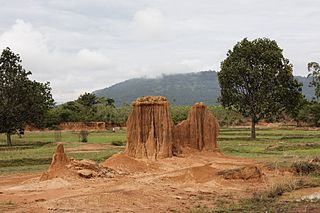
Sa Kaeo is one of the 76 provinces (changwat) and lies in eastern Thailand about 200 km from Bangkok. Neighboring provinces are Chanthaburi, Chachoengsao, Prachinburi, Nakhon Ratchasima, and Buriram. To the east it borders Banteay Meanchey and Battambang of Cambodia.

Phyllanthus is the largest genus in the flowering plant family Phyllanthaceae. Estimates of the number of species in this genus vary widely, from 750 to 1200. Phyllanthus has a remarkable diversity of growth forms including annual and perennial herbs, shrubs, climbers, floating aquatics, and pachycaulous succulents. Some have flattened leaflike stems called cladodes. It has a wide variety of floral morphologies and chromosome numbers and has one of the widest range of pollen types of any seed plant genus.

Phyllanthus acidus, known as the Otaheite gooseberry, Malay gooseberry, Tahitian gooseberry, country gooseberry, star gooseberry, starberry, arbari, West India gooseberry, or simply gooseberry tree, is one of the trees with edible small yellow berries fruit in the family Phyllanthaceae. Despite its name, the plant does not resemble the gooseberry, except for the acidity of its fruits. It tastes sour and tart.

Phyllanthus emblica, also known as emblic, emblic myrobalan, myrobalan, Indian gooseberry, Malacca tree, or amla, from the Sanskrit amalaki, is a deciduous tree of the family Phyllanthaceae.
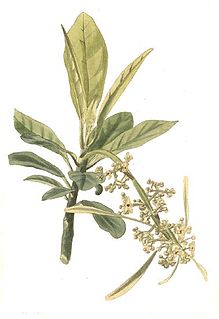
Omphalea is a plant genus of the family Euphorbiaceae first described as a genus in 1759. It is native to tropical parts of the Americas, the West Indies, Asia, Australia, and Africa.

Bridelia is a plant genus of the family Phyllanthaceae first described as a genus in 1806. It is widespread across Africa, Australia, southern Asia, and various islands of the Indian and Pacific Oceans.

Breynia is a plant genus in the family Phyllanthaceae, first described in 1776. It is native to Southeast Asia, China, the Indian Subcontinent, Papuasia, Australia, and the island of Réunion.

Glochidion is a genus of flowering plants, of the family Phyllanthaceae, known as cheese trees or buttonwood in Australia, and leafflower trees in the scientific literature. It comprises about 300 species, distributed from Madagascar to the Pacific Islands. Glochidion species are used as food plants by the larvae of some Lepidoptera species including Aenetus eximia and Endoclita damor. The Nicobarese people have attested to the medicinal properties found in G. calocarpum, saying that its bark and seed are most effective in curing abdominal disorders associated with amoebiasis.

Phyllanthus mirabilis is a plant species of family Phyllanthaceae and is native to Thailand, Laos and Myanmar. It is one of the only four Phyllanthus to be caudiciform and the one of the only two caudiciform Phyllanthus to be described, with the other being Phyllanthus kaweesakii. The leaves fold together at night. Wild plants are found on limestone mountains and cliffs.

Kaeng Krachan National Park is the largest national park of Thailand. It is on the border with Burma, contiguous with the Tanintharyi Nature Reserve. It is a popular park owing to its proximity to the tourist town of Hua Hin. It was named a UNESCO World Heritage Site on 26 July 2021, despite concerns from the OHCHR around the human rights violations of the indigenous people that live in the park.

Thung Salaeng Luang National Park is a 1,262 km2 (487 sq mi) national park in Phitsanulok and Phetchabun Provinces of Thailand. It encompasses substantial portions of Wang Thong and Lom Sak Districts.
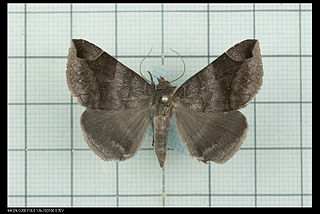
Bastilla amygdalis is a moth of the family Noctuidae. It is found in the Indian subregion, Sri Lanka, Taiwan, Thailand, Sumatra and Borneo.

Epicephala albifrons is a moth of the family Gracillariidae. It is known from India, Indonesia (Buru), Sri Lanka, Thailand and Vietnam.
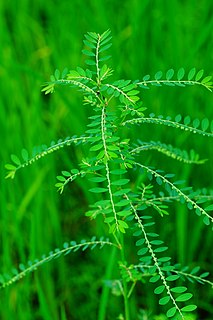
Phyllanthus niruri is a widespread tropical plant commonly found in coastal areas, known by the common names gale of the wind, stonebreaker or seed-under-leaf. It is in the genus Phyllanthus of the family Phyllanthaceae.

Phu Soi Dao National Park ;RTGS: Utthayan Haeng Chat Phu Soi Dao named after 2,120 m (6,960 ft) high Phu Soi Dao mountain, is a protected area at the southern end of the Luang Prabang Range in the Thai/Lao border area, on the Thai side of the range. It is located in Ban Khok and Nam Pat Districts of Uttaradit Province and Chat Trakan District of Phitsanulok Province. The park was established as Thailand's 109th national park in 2008.
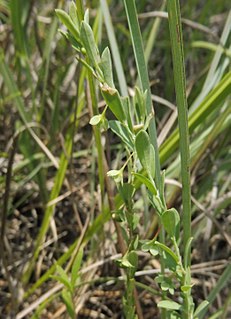
Phyllanthus polygonoides, known as smartweed leaf-flower or knotweed leafflower, is an herbaceous perennial plant in the family Phyllanthaceae. It grows from 10 to 50 centimeters in height. It is native to the United States and northern and central Mexico.

Phyllanthus reticulatus is a plant species described Jean Louis Marie Poiret; it is included in the family Phyllanthaceae.

Phyllanthus balgooyi is an herbaceous plant in the family Phyllanthaceae, found in Palawan and Sabah. The plant is a hyperaccumulator of nickel, with a concentration of the metal exceeding 16% in the plant's phloem sap.

















